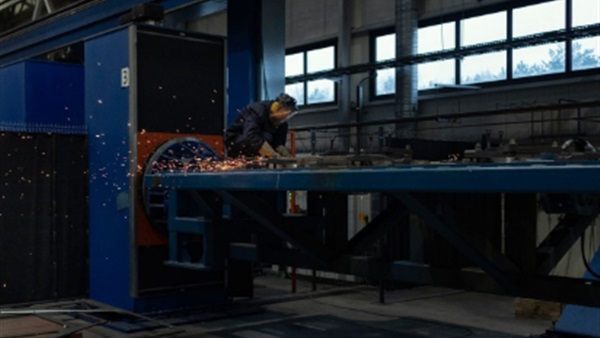The Covert Polish Repair Shop Patching Up Ukrainian Arms

In a sprawling factory complex surrounded by derelict
buildings, hundreds of technicians are working around the clock on one of the
biggest challenges of Ukraine’s war: repairing artillery and heavy armor and
returning it to the front line.
Mechanics buzz around the football-field-sized workshop
housing three AHS Krab guns, the air thick with the smell of metal dust and
automotive grease. Two of the Krabs, which look like tanks but are
self-propelled 155mm howitzer guns, are missing parts of their caterpillar
tracks and are riddled with bullet holes and contorted metal.
Another Krab stands sparkling clean, ready to be ferried
back into Ukraine along a route that has seen the biggest transfer of arms in
Europe since World War II. Each weapon can take up to two months to repair by
technicians who must pass layers of security checks before they are allowed
onto the floor of the factory at a location The Wall Street Journal agreed not
to disclose.
In addition to the repair work in Poland, the mechanics are
in constant contact with technicians in Ukraine—many of whom were civilians
before the war—teaching them over encrypted apps how to repair everything from
tanks to missiles.
“That one actually arrived here in the worst condition we
have seen,” says engineer Mirosław Surowaniec, pointing to the revitalized
Krab, one of 10 guns repaired in recent months. “The entire gun barrel was
missing, the body badly damaged.”
The maintenance and repair of munitions is a major challenge
in a war that is burning through arms at the fastest pace since Nazi Germany
clashed with Soviet Russia on the same territory almost 80 years ago.
The scale of the previously unreported Polish armaments
operation highlights the complexity of a maintenance challenge that is about to
grow far larger. On Wednesday, the Biden administration announced plans to send
31 M1 Abrams tanks to Ukraine, joining European allies who will send as many as
100 German-made Leopard 2 tanks.
Polish officials say they expect the Abramses will be
repaired in Poland in the western city of Poznan, making the former Soviet
satellite state the leading edge of a maintenance operation that stretches to
the Czech Republic, Romania and Bulgaria. Poland will also likely play a
critical role in repairing and maintaining the Leopards, due to its arms
industry’s deep experience with the tank.
“It is safe to assume
that Poland is a leader when it comes to servicing the equipment being used by
the Ukrainians in the battlefield,” said Tomasz Smura, an expert on military technologies
from Casimir Pulaski Foundation, an independent think tank in Warsaw.
Ukrainian President Volodomyr Zelenskyy thanked Poland on
Friday for agreeing to transfer 74 tanks, which include 30 PT-91s and 14
Leopard 2s.
The challenge of maintaining Ukrainian munitions, including
the tanks, comes as both Ukraine and Russia are planning offensives. Until now,
Ukraine has largely used tanks such as the Soviet-era T-72, including those transferred
by former Soviet satellite states including Poland.
A year of intense combat has exacted a heavy toll on tanks
and artillery pieces whose cannon barrels have been warped by frequent fire. To
remain operative, the materiel not only needs repair but also parts, plus
Soviet-caliber ammunition that the West doesn’t produce in significant
quantity.
In Russia, where the economy has been mobilized to support
the war effort, Prime Minister Mikhail Mishustin announced in a September
decree that he would create two new arms-repair hubs in the Moscow and Rostov
regions, according to state media.
In Poland, the Krab Howitzers—first produced in 2017—are
being serviced at a facility owned by the Polish Armaments Group, a state
armaments company.
The workshop is monitored by armed officers from the
Internal Security Agency, tasked to scout for potential sabotage operations
that have hit weapons factories in other countries, including Bulgaria.
Every one of the roughly 400 assembly and production
employees—and any visitor to the premises—must be a Polish citizen. The
screening process for new employees, regardless of rank, can take several
months.
On the factory floor, technicians work in three shifts
around the clock and are in regular contact with Ukrainians on the battlefield.
They share information about best techniques for repairs over encrypted
messages and a HelpDesk app that helps them to troubleshoot problems.
Polish mechanics said they once used the chat application to
teach a Ukrainian postman-turned-soldier to repair a missile.
Mechanics sometimes find soldiers’ belongings inside the
Krabs: a toothbrush, unfinished snacks or family photos. Dariusz Gawinek, a
mechanic, said that repairing the hardware has made him more committed to
helping the war effort.
“The Krabs arrive here with leaves, mud, sand, twigs stuck
to the body and caterpillars. It is Ukrainian soil,” he said. “It hit me really
hard the first time I went inside of one.”
Polish officials said the workshop could soon expand to
repair and maintain equipment manufactured abroad, but declined to detail any
specific plans.
Sławomir Kapusta, the workshop’s foreman, said he was moved
last August when a vehicle arrived that had almost been destroyed. “One always
wonders what happened to the crew under such circumstances,” he said.





